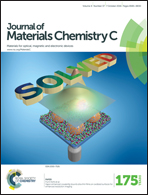Importing spontaneous polarization into a Heisenberg ferromagnet for a potential single-phase multiferroic†
Abstract
A novel two-dimensional Heisenberg ferromagnet with a flexible organic layer, [C6H5(CH2)4NH3]2[CuCl4], undergoes ferroelastic, ferroelectric and ferromagnetic transitions at 337, 143 and 7.8 K, respectively. The ferromagnet was characterized by variable-temperature thermal measurements, in situ single-crystal X-ray structure analyses, anisotropic dielectric measurements, and pyroelectric and magnetic analyses. Differing from the other layered perovskite-like compounds, this compound revealed an extraordinary distorted polar structure with five times the cell volume at its polar phase because of the flexibility of the organic layer. Hence, this presents an approach to introduce spontaneous electric polarization into the Heisenberg ferromagnet for single-phase multiferroics. Moreover, due to the cooperation between the frozen [C6H5(CH2)4NH3]+ cations and the tilting of the CuCl6 octahedra, this potential multiferroic compound simultaneously exhibits dielectric and magnetic bistabilities during both the ferroelastic and ferroelectric transitions.


 Please wait while we load your content...
Please wait while we load your content...